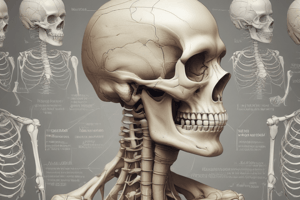Podcast
Questions and Answers
Which of the following is a typical long bone?
Which of the following is a typical long bone?
- Clavicle
- Patella
- Phalanges
- Fibula (correct)
Which of the following bones is considered a short bone?
Which of the following bones is considered a short bone?
- Humerus
- Femur
- Tibia
- Cuneiform (correct)
What is the definition of a joint?
What is the definition of a joint?
A junction between two or more bones or cartilages.
The patella is a sesamoid bone.
The patella is a sesamoid bone.
Match the following classifications of bones with their examples:
Match the following classifications of bones with their examples:
The __________ are the two ends of a long bone.
The __________ are the two ends of a long bone.
What type of joint is generally immovable?
What type of joint is generally immovable?
Which of the following bones would be classified as irregular bones?
Which of the following bones would be classified as irregular bones?
Name one example of a flat bone.
Name one example of a flat bone.
Flashcards are hidden until you start studying
Study Notes
Classification of Bones
-
Long Bones: Characterized by a shaft (diaphysis) and two smooth articular ends (epiphyses); contain a medullary cavity filled with bone marrow.
-
Typical Long Bones: Examples include the humerus, radius, ulna, femur, tibia, and fibula.
-
Mini Long Bones: Have one epiphysis; examples include metacarpals, metatarsals, and phalanges.
-
Atypical Long Bones: Lack a medullary cavity; an example is the clavicle.
-
Short Bones: Connected in groups; usually cube-shaped; examples include tarsal and carpal bones.
-
Sesamoid Bones: Bony nodules embedded in tendons or joint capsules; do not have a periosteum; ossify after birth. Key examples are the patella and pisiform bone.
-
Irregular Bones: Have no defined shape; examples include vertebrae, hip bones, and facial bones of the skull.
-
Flat Bones: Thin and flat, forming boundaries of certain body cavities; examples include cranium bones, ribs, sternum, scapula, and the ilium part of the hip bone.
Joints
- Definition: A junction between two or more bones or cartilages, allowing movement.
- Notably, children have more joints than adults due to bone fusion during growth.
- Examples of fusing bones include the ilium, ischium, and pubis forming the pelvic bone, and the two halves of the infant frontal bone and mandible.
Structural Classification of Joints
-
Types of Joints:
- Fibrous Joints: Generally immovable.
- Cartilaginous Joints: Slightly movable.
- Synovial Joints: Highly movable types.
-
Fibrous Joints Types:
- Sutures: Found in the skull.
- Syndesmosis: Connects bones via an interosseous ligament.
- Gomphosis: Joins teeth to their sockets in the jaw.
Studying That Suits You
Use AI to generate personalized quizzes and flashcards to suit your learning preferences.




